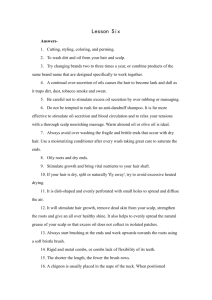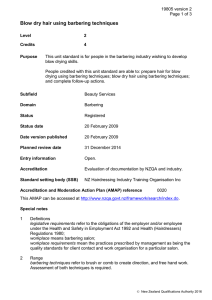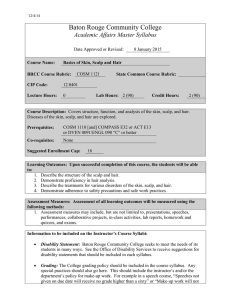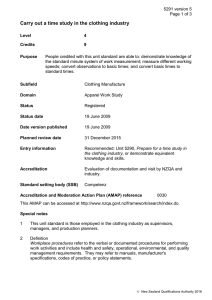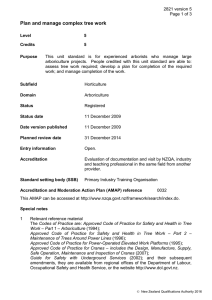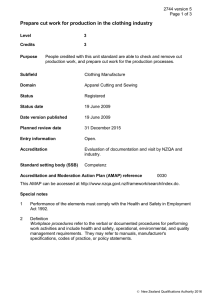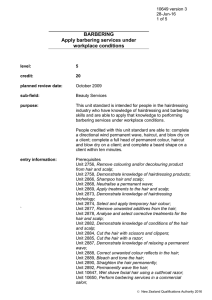Consult with client for barbering services and analyse hair and... conditions
advertisement
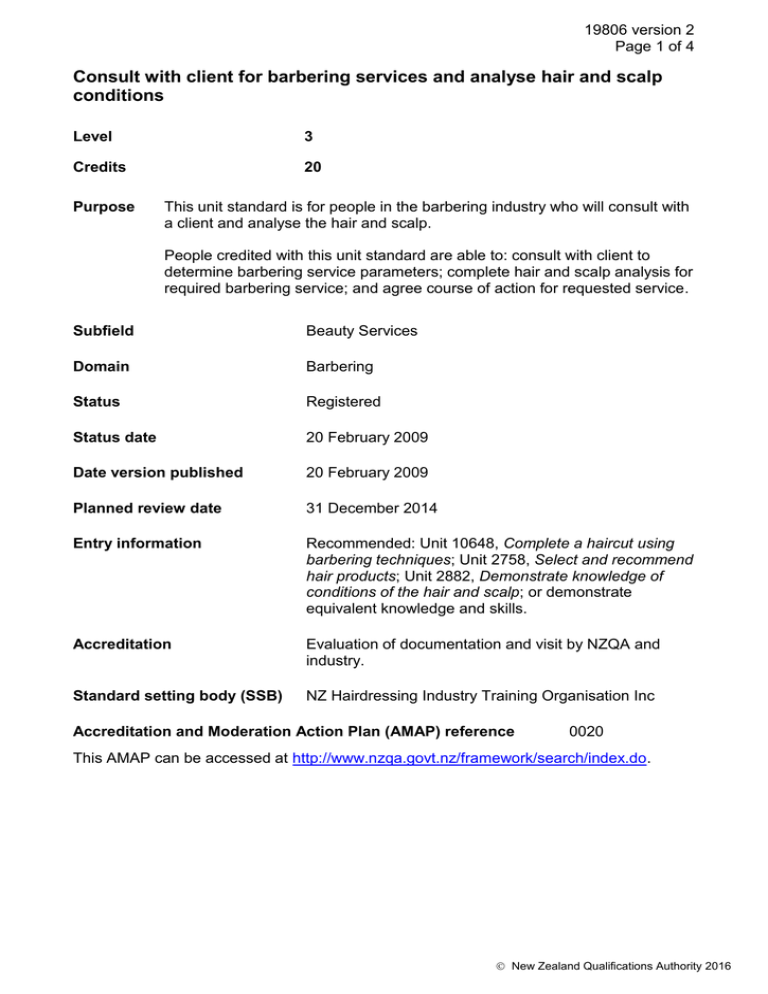
19806 version 2 Page 1 of 4 Consult with client for barbering services and analyse hair and scalp conditions Level 3 Credits 20 Purpose This unit standard is for people in the barbering industry who will consult with a client and analyse the hair and scalp. People credited with this unit standard are able to: consult with client to determine barbering service parameters; complete hair and scalp analysis for required barbering service; and agree course of action for requested service. Subfield Beauty Services Domain Barbering Status Registered Status date 20 February 2009 Date version published 20 February 2009 Planned review date 31 December 2014 Entry information Recommended: Unit 10648, Complete a haircut using barbering techniques; Unit 2758, Select and recommend hair products; Unit 2882, Demonstrate knowledge of conditions of the hair and scalp; or demonstrate equivalent knowledge and skills. Accreditation Evaluation of documentation and visit by NZQA and industry. Standard setting body (SSB) NZ Hairdressing Industry Training Organisation Inc Accreditation and Moderation Action Plan (AMAP) reference 0020 This AMAP can be accessed at http://www.nzqa.govt.nz/framework/search/index.do. New Zealand Qualifications Authority 2016 19806 version 2 Page 2 of 4 Special notes 1 Definitions legislative requirements refer to the obligations of the employer and/or employee under the Health and Safety in Employment Act 1992 and Health (Hairdressers) Regulations 1980; workplace means barbering salon; workplace requirements mean the practices prescribed by management as being the quality standards for client contact and work organisation for a particular salon. 2 In this unit standard all work must comply with legislative requirements and must ensure optimum hair condition and maximum client comfort at all times. Elements and performance criteria Element 1 Consult with client to determine barbering service parameters. Performance criteria 1.1 The consultation is carried out in a non-threatening and time-effective manner. Range 1.2 includes but is not limited to – body language, physical contact. Questions demonstrate empathy and identify client’s wants and/or needs. Range type and extent of haircut – tapering and balance, surplus hair, nape shaping and line outs. 1.3 The client's wants and/or needs are analysed in accordance with workplace requirements, and suggestions for services and products are made to meet client’s needs. 1.4 Questioning elicits information on previous chemical treatments which may affect proposed service. 1.5 Questioning elicits information on client’s life style, personality and home hair care routine. Range 1.6 any one of – fashion, professional, casual, sporty. Visual examination of client’s features, stature, and body proportions is carried out in terms of requirements of requested service. New Zealand Qualifications Authority 2016 19806 version 2 Page 3 of 4 Element 2 Complete hair and scalp analysis for required barbering service. Performance criteria 2.1 Scalp is examined in terms of requirements of requested service in accordance with workplace requirements. Range 2.2 Hair type is identified in terms of requirements of requested service in accordance with workplace requirements. Range 2.3 presence of curl, hairline, facial growth, nape growth, crowns, natural partings, thinning. Hair and scalp conditions are identified in accordance with legislative requirements. Range 2.5 porosity, elasticity, texture, density, length, growth patterns, percentage of grey, product build-up. Natural hair tendencies are identified in terms of requirements of requested service in accordance with workplace requirements. Range 2.4 scalp irregularities, scalp condition. contagious, non-contagious. Damaged hair is identified in terms of requirements of requested service in accordance with workplace requirements. Range physical, chemical. Element 3 Agree course of action for requested service. Performance criteria 3.1 The client is advised of factors that may influence achievement of requested service. Range 3.2 client's wants and/or needs, hair and scalp analysis, lifestyle analysis, fixed factors and variable factors, chemical treatments, time factors, probable price, proposed outcomes, home hair care, follow-up services and maintenance. Proposed course of action and final result are explained step-by-step in nontechnical terms in accordance with workplace requirements, and the confirmed outcome matches client’s wants and/or needs. New Zealand Qualifications Authority 2016 19806 version 2 Page 4 of 4 Please note Providers must be accredited by NZQA, or an inter-institutional body with delegated authority for quality assurance, before they can report credits from assessment against unit standards or deliver courses of study leading to that assessment. Industry Training Organisations must be accredited by NZQA before they can register credits from assessment against unit standards. Accredited providers and Industry Training Organisations assessing against unit standards must engage with the moderation system that applies to those standards. Accreditation requirements and an outline of the moderation system that applies to this standard are outlined in the Accreditation and Moderation Action Plan (AMAP). The AMAP also includes useful information about special requirements for organisations wishing to develop education and training programmes, such as minimum qualifications for tutors and assessors, and special resource requirements. Comments on this unit standard Please contact the NZ Hairdressing Industry Training Organisation Inc enquiries@hito.org.nz if you wish to suggest changes to the content of this unit standard. New Zealand Qualifications Authority 2016
